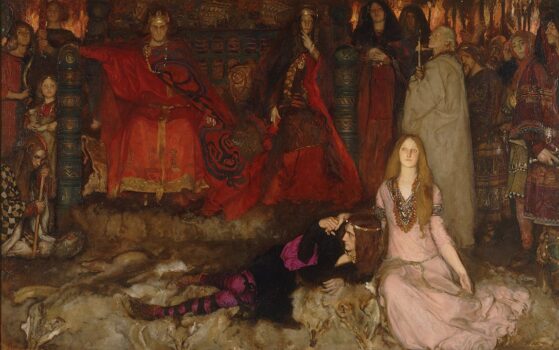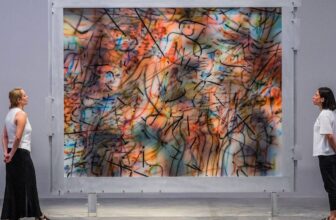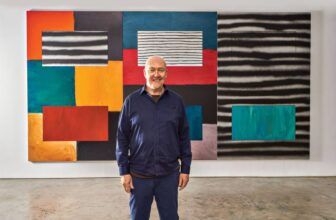What Are Edwin Austin Abbey’s Most Famous Paintings
In the calm galleries of the Boston Public Library, amid the vaulted ceilings and echoing marble corridors, the rich, dramatic murals of Edwin Austin Abbey still hold court, stoic, romantic, and timeless. Born in 1852 in Philadelphia, Abbey’s name may not ring as loudly as Michelangelo or Monet, but his influence and mastery remain etched deeply in the annals of American and British art history. A versatile painter, illustrator, and muralist, Abbey brought literature to life, captured myth and history with sweeping drama, and lent cultural prestige to institutions on both sides of the Atlantic.
But who was Edwin Austin Abbey, and what makes his art so captivating over a century later?
The Man Behind the Canvas
Edwin Austin Abbey began his artistic journey at the Pennsylvania Academy of the Fine Arts at the age of 14. However, he didn’t stay long. By 19, he had already begun illustrating for Harper’s Weekly, and his career as a prolific illustrator for major American publications was underway. His early fame grew thanks to his intricate pen-and-ink illustrations, often drawing inspiration from literary sources such as Shakespeare, Robert Herrick, and the works of English Romantic poets.
Abbey’s affinity for literature would define much of his artistic trajectory. He was part of the movement that elevated illustration to a respected art form during the “Golden Age of Illustration” in the late 19th century. Over time, his ambitions would move beyond black-and-white prints to full-scale murals and oil paintings that would earn him a place in the grand tradition of academic and historical painting.
What Was Edwin Austin Abbey Known For?
Abbey is best known for his richly detailed illustrations and murals inspired by literature, history, and legend. He made his mark illustrating scenes from Shakespeare’s plays with a depth of drama and period accuracy that few could rival. His paintings often exuded a romanticized medieval and Renaissance ambiance, populated with finely rendered fabrics, architecture, and lighting that hinted at his deep understanding of historical aesthetics.
Perhaps most notably, Abbey gained international recognition for his work on the Boston Public Library murals, a vast cycle based on the Arthurian legends. This project, which took years to complete, is often considered his magnum opus. He is also renowned for his contributions to the Pennsylvania State Capitol, where he created murals representing significant moments in American history.
Abbey was a master storyteller, using canvas and brush to weave together mythology, allegory, and historical narrative in a way that made the past come alive. He was not just painting events, he was recreating entire worlds.
What Art Style Is Edwin Austin Abbey Associated With?
Abbey’s style is best described as part of the Academic Art movement, with elements of Romanticism and Pre-Raphaelitism. His works were technically precise, characterized by a high level of craftsmanship, harmonious composition, and historical fidelity.
Academic Art focused on traditional subjects like history, literature, and religion, often executed with classical techniques and idealized forms.
Romanticism influenced his love of drama and emotion, evident in the gestural poses and vivid expressions of his subjects.
Pre-Raphaelite Influence came through in his lush detailing, deep colors, and admiration for medieval themes and symbolism.
Abbey’s fusion of these styles resulted in a distinctive visual language that was both intellectual and emotive, a rare balance in any era.
How Did Edwin Austin Abbey Create His Paintings?
Abbey’s process was meticulous. For major works, especially murals, he would begin with extensive research, immersing himself in the historical context and literary background of his subject. He would then sketch numerous preliminary studies and compositional layouts, often in charcoal or ink. These studies helped him resolve everything from lighting and anatomy to costume design.
For his oil paintings and murals, Abbey employed traditional techniques. He used a layering process, beginning with underpainting to establish tone and structure, followed by glazes and details that brought richness and depth to the surface. His attention to costume accuracy and architecture reflected a scholarly approach, he treated his paintings almost like stage productions.
He often collaborated with assistants and craftsmen, especially for monumental works. In England, where he spent much of his later life, he worked closely with the architect Sir Edwin Lutyens and shared studio space with John Singer Sargent, with whom he collaborated on murals for the Boston Public Library.
How Many Artworks Did Edwin Austin Abbey Create?
Although the exact number is difficult to quantify, Abbey is believed to have produced hundreds of artworks over his lifetime. This includes:
Illustrations: Over 200 for Harper’s Weekly alone.
Murals: Multiple large-scale commissions for public institutions.
Oil Paintings: Dozens of narrative scenes, many of which are held in museums or private collections.
Studies and Sketches: Countless preparatory works that still circulate in auctions and galleries.
His prolific output, particularly in the realm of illustration, helped bridge the gap between commercial art and fine art, a feat few artists of his era accomplished so successfully.
What Are Edwin Austin Abbey’s Most Famous Paintings?
Here are some of Abbey’s most celebrated works:
1. “The Quest of the Holy Grail” Murals (1890–1901) – Boston Public Library
A cycle of 15 murals depicting the Arthurian legends. This monumental series is Abbey’s most iconic work, blending myth, spirituality, and narrative elegance.
2. “King Lear: Cordelia’s Farewell” (1898)
A deeply emotional rendering of the Shakespearean tragedy, capturing the moment Cordelia is banished. The composition and emotional depth highlight Abbey’s Shakespearean expertise.
3. “The Coronation of Edward VII” (1902–1904)
Commissioned by the British government, this grand painting marked Abbey’s place among England’s most respected artists.
4. Murals for the Pennsylvania State Capitol
These works celebrate American history with poetic reverence and historical integrity. They’re among his largest public contributions in the United States.
What Materials Did Edwin Austin Abbey Use?
Abbey’s medium varied depending on the project. Here are the most common materials he used:
Pen and Ink: For early illustrations, often published in Harper’s Weekly, Scribner’s, and Harper’s Magazine.
Oil on Canvas: For standalone easel paintings and mural works.
Tempera and Fresco: In some murals, especially those meant for public buildings, he experimented with fresco techniques.
Charcoal and Graphite: For studies and preliminary sketches.
He also employed gold leaf and gesso in decorative elements, particularly in mural borders or architectural collaborations. Abbey had a deep appreciation for craftsmanship and spared no expense in creating immersive visual environments.
Where Can Edwin Austin Abbey’s Paintings Be Found Today?
Today, Abbey’s artworks can be found in prestigious institutions and public spaces across the U.S. and the U.K.
Public Locations:
Boston Public Library (Boston, MA): “The Quest of the Holy Grail” mural cycle.
Pennsylvania State Capitol (Harrisburg, PA): Historical murals throughout the rotunda and legislative chambers.
Westminster Abbey (London, UK): Abbey contributed to design work and is honored with a memorial here.
The Royal Academy (London, UK): Various works in their archives, as Abbey was a member of the Royal Academy.
Museum Collections:
Yale University Art Gallery
Metropolitan Museum of Art (New York)
The Morgan Library & Museum (New York)
Victoria and Albert Museum (London)
Philadelphia Museum of Art
Private collections also contain many of Abbey’s drawings and smaller oil works, and they occasionally appear in auctions.
How Much Does Edwin Austin Abbey’s Paintings Cost?
The cost of Edwin Austin Abbey’s artworks varies significantly based on medium, provenance, and scale:
Illustrations and Studies: Smaller pen-and-ink drawings or charcoal sketches typically range from $5,000 to $25,000.
Oil Paintings: Depending on size and subject matter, oil paintings may sell for $50,000 to $500,000 or more.
Murals: These are generally not for sale as they are fixed in public buildings. However, if ever removed or transferred, their value would be in the millions, based on rarity and historical significance.
In 2006, Abbey’s painting “Scene from King Lear” sold for nearly $300,000 at Sotheby’s. That illustrates the demand for his larger, more narrative-driven pieces, especially those based on Shakespeare.
Edwin Austin Abbey Legacy and Influence
Edwin Austin Abbey was more than a painter, he was a cultural conduit. His ability to translate literature into visual language without diluting its meaning or complexity remains one of his greatest contributions. Through his brush, Abbey told the stories of kings and knights, of saints and sinners, with the same fidelity and vigor as the original texts.
He influenced generations of illustrators and muralists, including artists of the American Renaissance and Beaux-Arts movements. His collaborative friendships with John Singer Sargent and Lawrence Alma-Tadema also positioned him at the crossroads of Anglo-American art.
Though he passed away in 1911, Abbey’s artworks continue to evoke awe, telling tales as vividly today as they did over a century ago.
The Art of Storytelling in Paint
Edwin Austin Abbey is a towering figure in American and British art, not because he sought fame, but because he pursued excellence. Whether sketching a quiet moment in a Shakespearean soliloquy or rendering the celestial climax of the Arthurian grail quest, Abbey treated every image as a sacred narrative.
His works are more than historical records or decorative pieces; they are immersive stories, rendered with a craftsman’s precision and a poet’s soul.
In an age of fleeting digital images, Abbey’s timeless paintings invite us to slow down, to look deeply, and to listen to the silent tales embedded in brushstrokes, shadow, and light.




